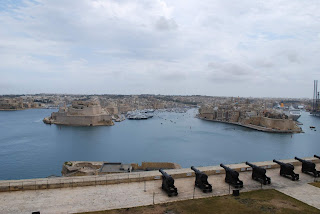From here it is no great distance to the capital, Valletta, though it can take over an hour because of the narrowness of the roads. The bus fare was only 1.50 Euros, and travelled there three times.
Valletta was built after the Knights Hospitaller had repelled (just!) the great Turkish siege of 1565, and named in honour of the man who commanded them. Within massive fortifications, it is built on a regular gridiron pattern, and contains several fine museums and noble Baroque buildings
as well as the "co-cathedral" of St. John the Baptist, which is supremely over-the-top, and owns two Caravaggio paintings.
The view over the Grand Harbour fromValletta I would rate as one of the finest in the world
The best way to view the massive fortifications is from the little boats plying the harbour. They look like gondolas with outboard engines!
These fortifications were built by the Knights after the great siege, in case the Turks attacked again - but in fact they never did.
Mdina, the old capital of Malta, is in the centre of the island. It also has impressive fortifications.
Within the walls there are many fine old buildings,
and an impressive cathedral
From the walls, you can see almost the whole island.
Outside the walls of Mdina is Rabat (which is merely the Arab word for a suburb). It is noted for several mazes of catacombs from the early Christian period
.
Malta has several unique temples, constructed from enormous rocks. They date from the Neolithic period, around 3,500 B.C., which makes them older than Stonehenge and a thousand years earlier than the Pyramids. This is the one at Hagar Qim, near the south-western coast of the island.
There are few surviving buildings that date from before the great siege of 1565. But in more recent times there has been a massive campaign of church-building. Even quite small towns boast huge churches, often with soaring domes; the most spectacular being at Mosta
Many of the hillsides still have terraces of tiny fields, supported by drystone walls originally built by the Arabs. Some are still farmed, but others have reverted to scrub or to thickets of prickly pear cactus; another Arab introduction.
I saw no farm animalsat all: we were told they were always kept indoors.
The coast has some spectacular features, such as the Blue Grotto.
But there are also modern seaside resorts, such as Marsaxlokk in the south-east.
Gozo, the island a short distance north of Malta, is quite different in many ways. I shall deal with Gozo in a later post.




















